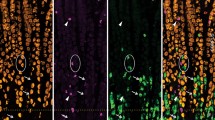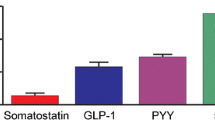Summary
The rabbit rectal gland consists of tubuli. The secretory cells are columnar elements with prominent apical cytoplasmic caps and protrusions extending into the glandular lumen. The cells contain relatively large lipid droplets but no mucosubstances. Intercellular canaliculi are absent from the rabbit rectal gland epithelium. The glands were also investigated histochemically. The following enzymes were demonstrated and localized: Oxydo-reductases of glycolysis, of the citric acid cycle, the respiratory chain and the pentosephosphat shunt; furthermore hydrolases and glycosidases. The glandular cells show a high level of activity of glycolytic oxydo-reductases and of enzymes yielding NADPH2. Only relatively low activity, however, was found of the dehydrogenases of the citric acid cycle. In addition we noticed a strong granular activity of non-specific acid phosphatase in the glandular epithelium.
Zusammenfassung
Die Glandulae rectales vom Kaninchen sind tubulöse Drüsen. Das einschichtige hochzylindrische Epithel der Drüsenschläuche enthält sudanophile Tröpfchen. Glykogen und Mucosubstanzen konnten nicht nachgewiesen werden. Die Apices der Drüsenzellen weisen blasen- oder kuppelförmige Protrusionen auf, die abgeschnürt werden. Interzelluläre Sekretkanälchen fehlen.
Ferner wurden eine Reihe von Oxydoreduktasen aus der Glykolysekette, dem Citronensäurezyklus, der Atmungskette sowie NADPH2 liefernde Enzyme und Hydrolasen mit histochemischen Methoden lokalisiert. Das Drüsenepithel ist mit hohen Aktivitäten der glykolytischen Dehydrogenasen und der Enzyme G-6-PDH und NADP-IDH ausgestattet. In den Drüsenzellen konnte außerdem eine starke Aktivität der unspezifischen sauren Phosphatase lokalisiert werden.
Similar content being viewed by others
Literatur
Barka, T., Anderson, P. J.: Histochemical methods for acid phosphatase using Hexazonium Pararosanilin as coupler. J. Histochem. Cytochem. 10, 741–753 (1962).
—: Histochemistry. Theory, practice and bibliography. New York-Evanston-London: Harper & Row, Publishers, Inc. 1965.
Bertolini, R., Pabst, R., Gabler, W.: Histochemische Untersuchungen der Analdrüsen des Kaninchens. Morph. Jb. 114, 329–336 (1970).
Braun-Falco, O., Rupee, M.: Apokrine Schweißdrüsen. In: Normale und pathologische Anatomie der Haut. I. Handbuch der Haut- und Geschlechtskrankheiten. Ergänzungsband zu Bd. I/1. Hrsg. O. Gans und G. K. Steigleder. Berlin-Heidelberg-New York: Springer 1968.
Brinkmann, A.: Die Hautdrüsen der Säugetiere. Bau und Sekretionsverhältnisse. Ergebn. Entwickl.-Gesch. 20, 1173–1231 (1911).
- Nachlese zu meinen Hautdrüsenuntersuchungen. Bergens Museums Aarbok, S. 3–36. 1932/24.
Burstone, M. S.: Histochemical comparison of naphthol-AS-phosphates for the demonstration of phosphatases. J. nat. Cancer Inst. 20, 601–611 (1958).
Buschke, W.: Die Hautdrüsenorgane (Hardersche Drüsen, Inguinaldrüsen, Präputialdrüsen, Analdrüsen, Kaudaldrüsen, Kieferdrüsen) der Laboratoriumsnagetiere und die Frage ihrer Abhängigkeit von den Geschlechtsdrüsen. Z. Zellforsch. 18, 217–243 (1933).
Gomori, G.: The distribution of phosphatase in normal organs and tissues. J. cell. comp. Physiol. 17, 71–83 (1941).
Graumann, W., Clauss, W.: Weitere Untersuchungen zur Spezif ität der histochemischen Polysaccharid-Eisenreaktion. Acta histochem. (Jena) 6, 1–7 (1958).
Gross, S.: Beiträge zur Anatomie der accessorischen Geschlechtsdrüsen der Insektivoren und Nager. Arch. mikr. Anat. 46, 567–608 (1905).
Grote, G.: Über die Glandulae anales des Kaninchens. Inaug.-Diss. Königsberg (1891).
Hayashi, M.: Histochemical demonstration of N-Acetyl-β-glucosaminidase employing naphthol-AS-BI-N-acetyl-β-glucosaminide as substrate. J. Histochem. Cytochem. 13, 355–360 (1965).
—, Nakajima, J., Fishman, W. H.: The cytologie demonstration of β-glucuronidase employing naphthol-AS-BI-glucuronide and hexazonium pararosanilin; a preliminary report. J. Histochem. 4, 293–297 (1964).
Hess, R., Scarpelli, D. G., Pearse, G. E. A.: The cytochemical localization of oxidative enzymes. II. Pyridine nucleotide-linked dehydrogenases. J. biophys. biochem. Cytol. 4, 753–760 (1958).
Holt, S. J., Withers, R. F. J.: Studies in enzyme histochemistry V. An appraisal of indigogenic reactions for esterase localization. Proc. roy. Soc. B 148, 520–531 (1958).
Ito, S.: Histologie und Zytologie der Schweißdrüsen. Igaku no Shimpo 6, 106–221 (1949).
Jerusalem, C.: Eine kleine Modifikation der Goldner-(Masson)-Trichromfärbung. Z. wiss. Mikr. 65, 320–321 (1963).
Kühnel, W.: Enzymhistochemische Untersuchungen an der Harderschen Drüse des Kaninchens. Histochemie 7, 230–244 (1966).
—, Burock, G., Petry, G.: Enzymhistotopochemische Studien an inaktiven Salzdrüsen von Hausenten (Anas platyrhynchus). I. Histiogramme einiger Oxydoreduktasen. Histochemie 19, 235–247 (1969).
—, Wrobel, K. H.: Morphologische Untersuchungen an den Glandulae inguinales des Kaninchens. I. Histotopochemie einiger Hydrolasen. Histochemie 8, 315–326 (1967).
—: Morphologische Untersuchungen an den Glandulae inguinales des Kaninchens. II. Die Histotopik von Oxydoreduktasen. Histochemie 10, 201–207 (1967).
—: Zur Morphologie der braunen Inguinaldrüse des Kaninchens. Z. Zellforsch. 93, 505–515 (1969).
Lev, R., Spicer, S. S.: Specific staining of sulphate groups with Alcian blue at low pH. J. Histochem. Cytochem. 12, 309 (1964).
Lillie, R. D.: Histopathologic technic and practical histochemistry, 2nd ed. New York-Toronto-Sydney-London: McGraw-Hill Book Co. 1954.
—: Histopathologic technic and practical histochemistry, 3rd ed. New York-Toronto-Sidney-London: McGraw-Hill Book Co. 1965.
Luh, W., Brandau, H.: Enzymologische Studien am normalen menschlichen Endometrium. Z. Geburtsh. Gynäk. 168, 14–50 (1967).
Minamitani, K.: Zytologische und histologische Untersuchungen der Schweißdrüsen in menschlicher Achselhaut. Okajimas Folia anat. jap. 20, 563–590 (1941).
Mowry, R. W.: The special value of methods that color both acidic and vicinal hydroxyl groups in the histochemical study of mucins. With revised directions for the colloidal iron stain, the use of Alcian blue 8 GX and their combinations with the periodic acid-Schiff reaction. Ann. N. Y. Acad. Sci. 106, 402–423 (1963).
Müller, H. B.: Die postnatale Entwicklung der Harderschen Drüse der weißen Ratte. II. Fermenthistochemische Befunde. Histochemie 20, 181–196 (1969).
Nachlas, M. M., Crawford, D. T., Seligman, A. M.: The histochemical demonstration of leucine aminopeptidase. J. Histochem. Cytochem. 5, 264–278 (1957).
—, Walker, D. G., Seligman, A. M.: A histochemical method for the demonstration of diphosphopyridine nucleotide diaphorase. J. biochem. Cytol. 4, 29–38 (1958a).
Ortmann, R.: Die Analregion der Säugetiere 3, (7), S. 1–68. In: Handbuch der Zoologie, herausgeg. von J. G. Helmcke, H. v. Lengerken u. D. Starck. Berlin: Walter de Gruyter & Co. 1960.
Padykula, H. D., Herman, E.: The specifity of the histochemical method for adenosine triphosphatase. J. Histochem. Cytochem. 3, 170–195 (1955).
Pearse, A. G. E.: Histochemistry. Theoretical and applied. London: I. & A. Churchill, Ltd. 1961.
Pearse, A. G. E.: Histochemistry. Theoretical and applied, vol. I. London: I. & A. Churchill, Ltd. 1968.
Petry, G., Kühnel, W., Beier, H. M.: Untersuchungen zur hormonellen Regulation der Präimplantationsphase der Gravidität. I. Histologische, topochemische und biochemische Analysen am normalen Kaninchenuterus. Cytobiologie 2, 1–32 (1970).
Rassner, G.: Zur enzymatischen Organisation des energieliefernden Stoffwechsels des normalen Meerschweinchens. Arch. klin. exp. Derm. 222, 391–402 (1965).
Rauther, M.: Über den Genitalapparat einiger Nager und Insektivoren, insbesondere die accessorischen Genitaldrüsen derselben. Jena. Z. med. Naturw. 38, 377–472 (1904).
Romeis, B.: Mikroskopische Technik, 16. Aufl. München u. Wien: R. Oldenbourg (1968).
Rutenburg, A. M., Rutenburg, S. H., Monis, B., Teague, R., Seligman, A. M.: Histochemical demonstration of β-D-galactosidase in the rat. J. Histochem. Cytochem. 6, 122–129 (1958).
Schaap, P. C. D.: Die Glandulae genitales accessoriae des Kaninchens im normalen Zustand und ihre Veränderung nach Kastration und nach Resektion der Vasa deferentia, 1. Aufl. Odercock Phys. Lab. Utrecht. Bekelharing u. Zwaardimarker 5. R. 130–135 (1899).
Schaffer, J.: Über die Hautdrüsen. Wien. klin. Wschr. 39, 1–5 (1926).
—: Die Hautdrüsenorgane der Säugetiere mit besonderer Berücksichtigung ihres histologischen Aufbaues und Bemerkungen über die Proktodäaldrüsen. Berlin-Wien: Urban & Schwarzenberg 1940.
Schiefferdecker, P.: Die Hautdrüsen des Menschen und der Säugetiere, ihre biologische und rassenanatomische Bedeutung sowie die Muscularis sexualis. Biol. Zbl. 37, 534–562 (1917).
—: Die Hautdrüsen des Menschen und der Säugetiere, ihre Bedeutung, sowie die Muscularis sexualis. Zoologica 72, 1–154 (1922).
Shimizu, N., Kumamoto, T.: A lead tetraacetate-Schiff method for polysaccharides in tissue sections. Stain Technol. 27, 97–106 (1952).
Tanaka, K.: Polarisationsoptische Analyse der Axillarorgane des Menschen. Z. Zellforsch. 56, 632–640 (1962).
Wrobel, K. H., Kühnel., W.: Zur Fermenthistochemie von Uterindrüsen und Uterusepithel in der geburtsreifen Schafplacenta. Z. Anat. Entwickl.-Gesch. 125, 357–366 (1966).
—: Fermenthistochemische Untersuchungen am geburtsreifen Schafplacentom. Zbl. Vet. -Med. A 14, 429–444 (1967).
Author information
Authors and Affiliations
Additional information
Mit dankenswerter Unterstützung durch die Deutsche Forschungsgemeinschaft (Ku 210/2).
Rights and permissions
About this article
Cite this article
Kühnel, W. Die Glandulae rectales (Proctodaealdrüsen) beim Kaninchen. Z. Zellforsch. 118, 127–141 (1971). https://doi.org/10.1007/BF00331771
Received:
Issue Date:
DOI: https://doi.org/10.1007/BF00331771




